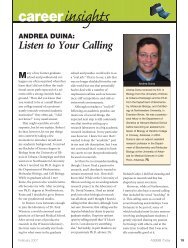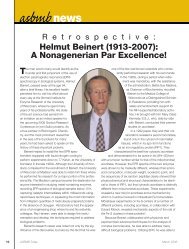View Program - asbmb
View Program - asbmb
View Program - asbmb
- TAGS
- program
- asbmb
- www.asbmb.org
You also want an ePaper? Increase the reach of your titles
YUMPU automatically turns print PDFs into web optimized ePapers that Google loves.
20<br />
Novel fluorescent probes to study sphingomyelin<br />
dynamics in living cells<br />
Claudio Giraudo 1 , Lavan Khandan 1 , Jeff Coleman 1 , James Rothman 1 .<br />
Yale University, New Haven, CT 06520 1<br />
Abstract:<br />
Sphingomyelin is a highly abundant lipid in eukaryotic membranes and has been implicated in<br />
modulating signal transduction, enzymatic reactions and viral budding from infected cells.<br />
Sphingomyelin, cholesterol and glycosphingolipids share the ability to decrease membrane<br />
fluidity by segregating laterally in the plane of the membrane and give rise to domains ranging<br />
from 20-100nm that are enriched in these lipids and specific proteins. The synthesis of most of<br />
these lipids is carried out in the Golgi Complex and from there, they are transported and<br />
concentrated at the plasma membrane. To investigate the dynamics of sphingomyelin in living<br />
cells and its ability to form nanodomains within the Golgi membranes we generated a fusion<br />
construct coding for a signal sequence, a fluorescent protein and the non-toxic region of lysenin<br />
toxin, which specifically binds to sphingomyelin. Expression of this construct in cultured cells<br />
showed a spotted distribution mainly concentrated in the perinuclear area with a scarce colocalization<br />
with Golgi markers. Temperature blockage at 20°C for 3 h considerably increased<br />
the level of co-localization with Golgi markers. Preliminary results showed that knocking down<br />
the expression of the sphingomyelin synthase-1 and -2 genes by using siRNA, and thus<br />
inhibiting sphingomyelin synthesis, resulted in a dispersal of the fluorescent marker throughout<br />
the cells. Further studies are required to determine whether Golgi components and cargo<br />
molecules are differentially included/excluded from sphingomyelin rich domains within the<br />
secretory pathway. Altogether, these results set the stage for future experiments to study the<br />
dynamics of sphingomyelin in living cells and can be used as springboard to study the dynamics<br />
of other lipids by using appropriate toxins that bind to them.






